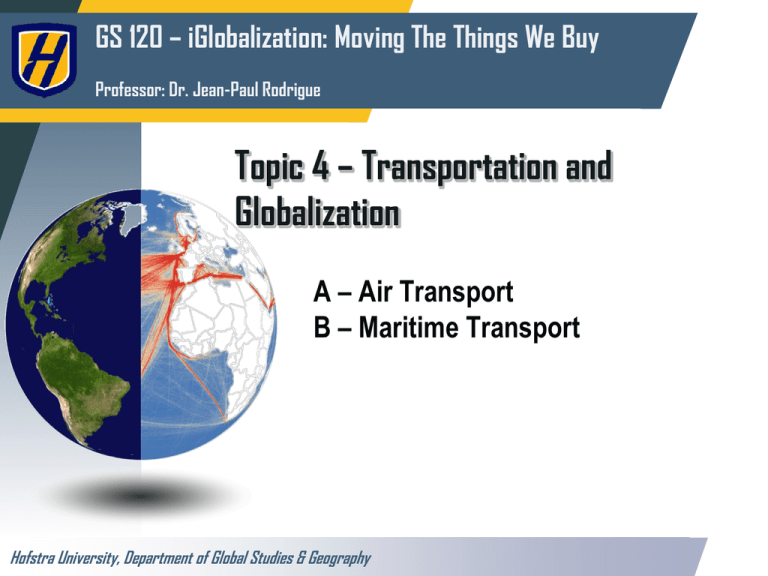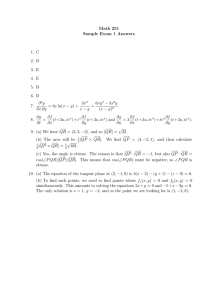Topic 4 – Transportation and Globalization A – Air Transport
advertisement

GS 120 – iGlobalization: Moving The Things We Buy Professor: Dr. Jean-Paul Rodrigue Topic 4 – Transportation and Globalization A – Air Transport B – Maritime Transport Hofstra University, Department of Global Studies & Geography A – Air Transport Read this section World Air Travel and World Air Freight Carried, 1950-2011 200 Passengers Freight Billions of passengers-km 5,000 4,000 180 160 140 120 3,000 100 80 2,000 1,000 60 40 20 0 0 Billions of tons-km 6,000 US Post Office Airmail Routes, 1921-26 Selected Transcontinental DC-3 Routes, Late 1930s Flight Times by Piston and Jet Engines from New York Factors behind the Development of Global Air Transportation Technical Improvements • Jet engine considerably reduced distances (1958: Boeing 707). • Greater speeds and improved ranges. • Almost every part of the world can be serviced in less than 24 hours Rising Affluence • Linked with income and economic output growth. • Disposable income available for leisure. • International tourism and air transportation are mutually interdependent. Globalization • Increasing migration and family relations (social networks). • Trade networks established by multinational corporations. Main Air Transport Service Ranges (From New York) Shortest Air Route between London and Sydney, 1955 2006 Main Commercial Passenger Aircraft, 1935-2011 Aircraft Year of First Commercial Service Speed (km/hr) Maximum Range at Full Payload (km) Seating Capacity Douglas DC-3 1935 346 563 30 Douglas DC-7 1953 555 5,810 52 Boeing 707-100 1958 897 6,820 110 Boeing 727-100 1963 917 5,000 94 Boeing 747-100 1970 907 9,045 385 McDonnell Douglas DC-10 1971 908 7,415 260 Airbus A300 1974 847 3,420 269 Boeing 767-200 1982 954 5,855 216 Boeing 747-400 1989 939 13,444 416 Boeing 777-200ER 1995 1030 14,300 300 Airbus A340-500 2003 886 15,800 313 Airbus A380 2007 930 14,800 555 Boeing 787-8 2011 1040 15,700 250 Air Unit Load Device New York / Hong Kong Air Routes: Conventional and Polar Average Airfare (roundtrip) between New York and London, 1946-2012 (in 2012 dollars) $9,000 $8,000 $7,900 $7,000 $6,000 $5,000 $4,980 $4,000 $3,160 $3,000 $2,000 $1,000 $725 $800 $0 1940 1950 1960 1970 1980 1990 2000 2010 2020 Operating Expenses of the Airline Industry 4.1% 2.4% 16.4% 7.0% 7.1% 12.2% 7.4% 10.1% 12.0% 10.5% 10.8% Promotion and sales Administration Fuel Station expenses Passenger services Maintenance Flight crew Other Depreciation & amortization Airport charges Enroute facility charges Number of Yearly Fatalities due to Air Transport Crashes, 1918-2011 5,000 4,500 4,000 3,500 3,000 Causes: Human error (67%); Technical (20%); Weather (6%) Occurrences: Less than 10 km from an airport (54%) Take off (21%) and Landing (50%) 2,500 2,000 1,500 1,000 500 1918 1921 1924 1927 1930 1933 1936 1939 1942 1945 1948 1951 1954 1957 1960 1963 1966 1969 1972 1975 1978 1981 1984 1987 1990 1993 1996 1999 2002 2005 2008 2011 0 Deaths Billions of passengers-km Apr-12 Apr-11 Apr-10 Apr-09 Apr-08 Apr-07 Apr-06 Apr-05 Apr-04 Apr-03 Apr-02 Apr-01 Apr-00 Apr-99 Apr-98 Apr-97 Apr-96 Apr-95 Apr-94 Apr-93 Apr-92 3.5 Apr-91 Apr-90 USD per Gallon Jet Fuel Prices, 1990-2012 4.5 4 Fuel around 40-50% of operating costs 3 2.5 2 1.5 1 0.5 0 World’s 10 Largest Passengers and Freight Airlines, 2010 US Airways Cargolux China Eastern Airlines EVA Air Air France-KLM China Airlines China Southern Airlines Singapore Airlines Ryanair Lufthansa Lufthansa Emirates American Airlines Korean Airlines Southwest Airlines Cathay Pacific United Airlines United Parcel Service Delta Air Lines Federal Express 0 50,000 100,000 150,000 200,000 Thousands of Passengers 0 5,000 10,000 15,000 20,000 Millions of Ton-km World’s Largest Freight Airports (in metric tons) Bangkok (BKK) 2000 New York (JFK) 2005 Chicago (ORD) 2010 Amsterdam (AMS) London (LHR) Beijing (PEK) Los Angeles (LAX) Taipei (TPE) Miami (MIA) Singapore (SIN) Louisville (SDF) Tokyo (NRT) Dubai (DXB) Frankfurt (FRA) Paris (CDG) Anchorage (ANC) Incheon (ICN) Shanghai (PVG) Memphis (MEM) Hong Kong (HKG) 0 500,000 1,000,000 1,500,000 2,000,000 2,500,000 3,000,000 3,500,000 4,000,000 4,500,000 Freight Traffic at the World’s Largest Airports, 2010 B – Maritime Transport Read this section Modal Shares of World Trade by Volume and Value, 2008 Volume 0.25 Value 9.96 14.32 Seaborne Airborne Overland 89.79 12.97 72.71 Explain the differences between the importance in the volume and value of trade by mode. Seaborne Airborne Overland Seaborne Trade & Exports of Goods International Seaborne Trade and Exports of Goods, 19552010 16 15 14 13 12 11 10 9 8 7 6 5 4 3 2 1 0 Seaborne Trade (billions of tons of goods loaded) - Left Axis 2.5 Exports of Goods (trillions of current $US) - Left Axis Ratio Exports / Seaborne Trade - Right Axis 2 1.5 1 0.5 0 Domains of Maritime Circulation Maritime Enclaves (Landlocked Countries) Types of Vessels Passenger ferries Carried across relatively short bodies of water in a shuttle-type service. Tend to be small and fast vessels, except for high volume markets (e.g. English Channel). Many are RORO vessels. Cruise ships Trips of various durations, usually over several days. Several amenities (restaurants, theaters, swimming pools, casinos) . Usually very large capacity ships. Before air transportation, serviced by liner passenger ships, dominantly over the North Atlantic. RORO vessels Roll on – Roll off Allow cars, trucks and trains to be loaded directly on board. The largest are the car carriers that transport vehicles from assembly plants to main markets. RO-RO Cargo Ship Types of Vessels Bulk cargo Freight, both dry or liquid, that is not packaged. Minerals (oil, coal, iron ore) and grains. Use of specialized ships such as oil tankers. Specialized transshipment and storage facilities. Single origin, destination and client. Prone to economies of scale. Break-bulk cargo Cargo packaged in some way (bags, boxes or drums). Numerous origins, destinations and clients. Before containerization, economies of scale were difficult to achieve. Dominance of the containership. World Tonnage by Cargo Vessel Type, 1970-2012 (in millions dwt) 1,600 1,400 1,200 1,000 Other Containerships General cargo Dry Bulk Oil tankers 800 600 400 200 0 1970 1980 1985 1990 1995 2000 2001 2002 2003 2004 2005 2006 2007 2008 2009 2010 2011 2012 Ultra Large Ore Carrier, the Berge Stahl Liquid Natural Gas Carrier (bulk) Reefer Ship The Evelyn Maersk (Containership: break-bulk) Stacked Upper Deck of a Containership Container Yard Operations, Cartagena, Colombia Six Generations of Containerships Early Containerships (1956-) A 500 – 800 TEU (LOA – Beam – Draft) 137x17x9 Fully Cellular (1970-) E 8 13 B 13 6 15 5 300x43x14.5 New Panamax (2014-) 366x49x15.2 17 C 6 10 12,500 TEU 20 6 D 397x56x15.5 ; 22–10–8 (not shown) 15,000 TEU 18,000 TEU 6 5 9 Post Panamax Plus (2000-) Triple E (2013-) 4 containers high below deck 285x40x13 4,000 – 5,000 TEU Post New Panamax (2006-) A 10 9 6,000 – 8,000 TEU D 5 4 290x32x12.5 Post Panamax (1988-) C 8 6 containers across 4 containers high on deck 250x32x12.5 3,000 – 3,400 TEU 3,400 – 4,500 TEU 6 215x20x10 Panamax (1980-) Panamax Max (1985-) 4 200x20x9 1,000 – 2,500 TEU B 4 10 400x59x15.5 8 23 E Types of Maritime Routes Port-to-Port Point to point service. Return empty. Common for bulk freight. Pendulum Shipping service moving back and forth between two maritime ranges (seaboards). Balancing the number of port calls and the frequency of services. Round-the-World Servicing continuously a sequence of ports. Sequence enables a round trip around the world. Limited amount of ports per continent are serviced. Involve a series of transshipment hubs. Three Major Pendulum Routes Serviced by OOCL, 2006 Global Maritime Piracy, 2008-2009 World’s Major Container Ports, 2010


